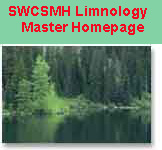Disclaimer & Copyright Notices; Optimized for the MS Internet Explorer
(Spongillaflies)
Soil & Water Conservation Society of Metro Halifax (SWCSMH)
Updated: October 09, 2013 
Contents:
- Superphylum Arthropoda
- (jointed-legged metazoan animals [Gr, arthron = joint; pous = foot])
- Phylum Entoma
- Subphylum Uniramia
- (L, unus = one; ramus = branch, referring to the unbranched nature of the appendages)
- Superclass Hexapoda
- (Gr, hex = six, pous = foot)
- Class Insecta
- (L, insectum meaning cut into sections)
- Subclass Ptilota
- Infraclass Neopterygota
Introduction
The order Neuroptera is closely related to
the order Megaloptera in the infraclass Neoptera, division
Endopterygota. Only 1 of 40 families of this order-- Sisyridae-- has
aquatic larvae. Two genera of the Sisyridae occur in North America,
both having terrestrial eggs, pupae, and adults. Larvae are highly
specialized predators on freshwater sponges; thus they are called
spongillaflies.
Life History
They are holometabolous. Adults live about 2
weeks. Sisyrids may go through 2 to 5 generations each year depending
on ambient temperature and food conditions. They overwinter as
third-instar larvae or prepupae. The larvae pass through 3 instars
before swimming to the shore and crawling out onto the bank.
Habitat and Ecological preference
Sisyrid larvae live exclusively in
association with freshwater sponges, either on the surface or in the
body cavities of their hosts. They are classified as climbers,
clingers, or burrowers.
While the habitat of freshwater
sponges and, thus, of sisyrids, ranges from cool, clean lakes and
streams to relatively polluted ponds, the former is more typical.
Feeding
Larval sisyrid mouthparts are highly
modified for piercing the tissues and sucking the contents of sponges.
Adult spongillaflies feed on nectar and pollen.
Indicator value
Sisyrid larvae live exclusively in
association with freshwater sponges, either on the surface or in the
body cavities of their hosts. They are classified as climbers,
clingers, or burrowers. While the habitat of freshwater sponges and,
thus, of sisyrids, ranges from cool, clean lakes and streams to
relatively polluted ponds, the former is more typical (Pennak, 1978)
Only 2 genera occur, Climacia and Sisyra. Their life cycle is similar to the megalopterans. Neither has indicator value (Mackie, 2001).
References and web URLs:
- Peckarsky, B.L., P.R. Fraissinet, M.A.
Penton, and D.J. Conklin, Jr. 1990. Freshwater Macroinvertebrates of
Northeastern North America. Cornell Univ. Press. xii, 442pp.
- Mackie, G.L. 2001. Applied Aquatic Ecosystem Concepts. Kendall/Hunt Publishing Company. xxv, 744 pp. ISBN 0-7872-7490-9
- Pennak, Robert W. 1978. Fresh-Water
Invertebrates of the United States. Second Edition. John Wiley &
Sons. ISBN: 0-471-04249-8. xviii, 803p.
- Wetzel, R.G. 1983. Limnology. 2nd ed. Saunders College Publishing. Xii, 767pp, R81, I10.
- Williams, D.D., and Feltmate, B.W. 1992. Aquatic Insects. CAB International. ISBN: 0-85198-782-6. xiii, 358p.


We salute the Chebucto Community Net (CCN) of Halifax, Nova Scotia, Canada for hosting our web site, and we applaud its volunteers for their devotion in making `CCN' the best community net in the world